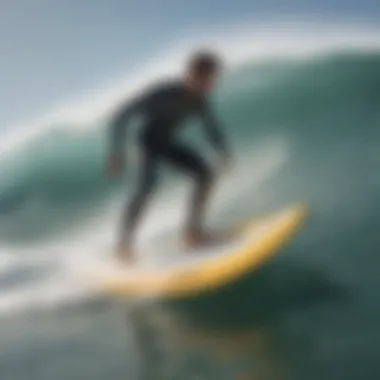A Deep Dive into Bic Surfboard Fins for Surfers


Intro
When discussing surfboards, enthusiasts often focus on shapes, sizes, and graphics. Yet, one component plays a pivotal role in the surfing experience: surfboard fins. They might be the unsung heroes of water sports, but their impact is felt every time one hits the waves. This guide takes a deep dive into Bic surfboard fins—how they’re designed, crafted, and how to choose the right one for your surfing style and conditions.
The relationship between a surfer and their fins can be likened to that of a dancer and their shoes. Just as the right pair can enhance performance and comfort, the right fins can substantially improve a surfing experience. Since Bic offers a diverse range, understanding their unique characteristics will unlock better maneuvers and greater enjoyment.
Throughout this article, we’ll explore the different types of Bic fins, their materials, and how they influence performance on the water. Additionally, we’ll provide insights for maintenance and discuss how to navigate compatibility issues that may arise. Whether you're picking up a board for the first time or are seasoned in the water, there's a wealth of information that can enhance your approach.
As surfers of all levels charge through the diverse waves, the insights gleaned from this exposition will be invaluable tools, guiding every twist and turn made on the water.
So, strap on your leash and get ready to paddle into the deeper waters of Bic surfboard fins!
Understanding Surfboard Fins
Surfboard fins, although often overlooked, play a pivotal role in the surfing experience. These seemingly simple appendages are not just there for aesthetics; they are key players in determining the performance and handling of a surfboard. An understanding of fins can enhance a surfer's ability to navigate waves, control speed, and execute turns. Thus, this section will help readers appreciate the nuances of surfboard fins, empowering them to make informed decisions about their equipment.
The Role of Fins in Surfing
Fins are crucial for traction and stability when riding a wave. Consider them the tires of a car. Without good tires, even the best vehicle struggles with control. Similarly, fins help surfers maintain a grip on the board, allowing for better balance and direction. They provide control in varying conditions, whether it's a mellow beach break or a powerful reef break. In essence, fins enable surfers to harness the energy of the ocean effectively and efficiently.
How Fins Influence Performance
The performance of a surfboard greatly depends on the design and configuration of its fins. The shape, size, and placement of fins affect several aspects like speed, maneuverability, and stability in the water. For instance, larger fins offer more grip but can slow a surfer down, while smaller fins might enhance speed but could compromise stability. Thus, selecting the right fins is not just about personal preference—understanding how different fins interact with wave dynamics is key.
Types of Surfboard Fins
Choosing the right setup is crucial to maximizing performance. Here, we explore the four primary types of surfboard fin setups:
Thruster Fin Setup
The thruster fin setup consists of three fins: one center fin and two side fins. This configuration offers a harmonious balance between stability and maneuverability. The key characteristic of the thruster setup is its versatility. It's popular for many surfing styles, from small waves to heavier surf. A unique feature is that it allows for quick turns while maintaining speed, which is its trump card in competitive surfing. However, in very powerful and hollow waves, some surfers feel it lacks the hold that a larger fin setup might provide.
Quad Fin Setup
A quad fin setup includes four fins—two on each side. This design helps with increased speed and maintaining control on bigger waves. The primary characteristic that sets the quad apart is its ability to provide a looser yet stable ride. This is particularly beneficial for surfing on clean, fast waves where high speed is the priority. One unique nuance is that it usually allows for better paddling efficiency, as the distribution of surface area permits enhanced glide. But on more challenging surf days, less grip might be a concern for certain surfers.
Single Fin Setup
The single fin setup is traditional and features one large fin in the center. This setup is known for its simplicity and provides a smooth ride. The key feature is its ability to glide effortlessly, making it ideal for cruising on smaller waves. Part of its charm lies in the classic style it brings to longboards. However, the trade-off here might be maneuverability in tighter situations; many find it challenging to perform sharp turns due to its size.
Five Fin Setup
As the name suggests, the five fin setup allows for maximum customization. Surfers can utilize all five fins for maximum stability or opt for a thruster or quad setup, depending on the conditions. The standout feature of a five fin setup is its adaptability. Surfers who encounter varying wave conditions benefit immensely, as they can switch configurations to match the situation. However, excessive fin options can be confusing for novices, making it essential to understand the purpose behind each setup.
An Overview of Bic Surfboard Fins
When it comes to surfboard fins, understanding what sets different brands apart can make all the difference. Bic surfboards, well-known in the water sports realm, have built a solid reputation when it comes to surfboard fins. This section aims to shed light on Bic surfboard fins, emphasizing their design, materials, and overall impact on a surfer's performance. Knowing these details can aid in making informed choices that elevate both enjoyment and competence out on the waves.


History of Bic Surf Products
Bic Sport, often just referred to as Bic, began carving their niche in the mid-seventies. Originating from France, the brand quickly established a foothold in the sailing and windsurfing world before branching into surfing. Throughout the years, Bic has evolved, continuing to innovate while ensuring that quality remains a focal point.
The evolution of Bic surfboard fins reflects the company's broader ethos. Initially, the fins were designed with simplicity in mind, relying on basic materials and straightforward shapes. Many early adopters noted that these fins possessed a user-friendly appeal, making it easier for beginners to learn the ropes while not overwhelming seasoned surfers. Over time, as technology advanced, Bic began incorporating various materials and designs that spoke to the demands of different surfing styles and skill levels. This historical perspective is invaluable, as it provides context for how Bic has fine-tuned their fins to suit diverse needs.
Bic's Approach to Fin Design
Bic's approach toward surfboard fin design stands out for several reasons. They focus heavily on practical innovation, striving to tweak technical details without losing sight of the user experience. Baker's dozen of design philosophies can be identified:
- Material Quality: Bic believes in the power of the materials used. From fiberglass to plastic, every choice impacts not just durability but also performance.
- Function Over Form: While aesthetics play a role, the functionality of fins remains paramount. Bic designs often prioritize how the fins affect maneuverability and stability—two crucial elements for any surfer.
- Inclusive Designs: Whether you’re riding a longboard or a shortboard, Bic produces fin models that cater to a variety of surfboards, ensuring compatibility across their broader product line.
- Performance Testing: Through rigorous testing in diverse conditions, Bic collects data that informs the evolution of their fin designs. This helps align their products with what surfers actually need in real-world scenarios.
- Market Responsiveness: Bic maintains an adaptable strategy, often interacting with both pro surfers and recreational riders to understand their needs. This leads to adjustments based on feedback, enhancing performance and user satisfaction.
It's crucial to note that Bic also places an emphasis on sustainability, pushing towards eco-friendly materials whenever possible. This not only demonstrates innovation in design but also an understanding of the larger environmental context in which these products exist.
In summary, an overview of Bic surfboard fins reveals their historical significance and a thoughtful approach to design and materials. By focusing on performance while also considering environmental impacts, Bic has carved out a respectful place in the highly competitive surf equipment market. Understanding this perspective equips current surfers with better tools for selecting the right fins for their own unique experiences.
Material Considerations for Bic Fins
When diving into the realm of Bic surfboard fins, the materials used in their construction play a crucial role in both performance and durability. Choosing the right material can significantly impact how a fin reacts in various surfing conditions. Through understanding the properties of different materials, surfers can make informed decisions that enhance their overall experience on the water.
Construction Materials Used
Plastic
Plastic fins are quite the common sight among many beginner boards. This is primarily due to their affordability and lightweight nature. They bring several benefits to the table, like resistance to impact and often being coupled with flexibility which is suitable when learning the tricks of the trade.
A notable feature of plastic is its durability under rough handling. While they might lack the performance edge that more advanced materials provide, they serve their purpose well for casual surfers. However, if you are looking for responsiveness and speed, you might find their performance to be somewhat limited when faced against waves or more aggressive maneuvers.
Fiberglass
Fiberglass fins pride themselves on striking a balance between strength and weight. Surfers tend to appreciate this material as it provides a more refined feel while riding waves. They have a specific rigidity that helps in more precise control of turn initiation and stability at higher speeds.
While fiberglass fins can offer superior performance compared to plastic, they do come with their own set of challenges. They are more prone to chipping if mishandled, necessitating careful storage and maintenance.
Carbon Fiber
Carbon fiber fins are the crème de la crème of fin materials, often preferred by seasoned surfers who demand high performance. Their exceptional stiffness combined with a lightweight design translates into a high degree of responsiveness on the water. The ability to handle large amounts of force without losing shape makes them a popular choice for those looking to push the limits of their riding style.
However, the price tag can be a deterrent for some, as carbon fiber fins tend to be on the expensive side. Still, their long-term value cannot be overstated. While cheaper options might save cash initially, the performance dividends of carbon fiber can make it worth every penny.
Impact of Material on Performance
The material of your Bic fins can essentially dictate how you ride across different wave conditions. Each type of material brings its own strengths and weaknesses:
- Plastic: Suitable for beginners but limited in performance.
- Fiberglass: Offers better control and stability at higher speeds.
- Carbon Fiber: Excellent for advanced maneuvers, but at a higher cost.
In essence, selecting a fin isn’t just about picking what looks good; it’s about considering how each material influences your surfing experience.
"The fin plays an essential role in guiding your surfboard's performance; understanding materials can align your choice with your surfing goals."


By understanding these material considerations, surfers can align their fin selection with their personal riding style and environmental conditions, ultimately leading to a more enhanced surfing experience.
Choosing the Right Bic Fins
Selecting the appropriate fins for your Bic surfboard can make or break your surfing experience. Choosing the right fins involves more than just picking a brand; it’s a tailored decision that depends on personal skill level, style, environmental factors, and compatibility with your surfboard. These elements work in unison to enhance performance, control, and enjoyment on the waves. By carefully assessing these factors, surfers can unlock their full potential and truly enjoy their time in the water.
Assessing Skill Level and Surfing Style
Understanding your skill level is paramount in selecting Bic fins. Beginners, often still mastering the basics, benefit from a more stable fin setup such as a thruster configuration. This offers better balance and easier maneuverability, which can boost confidence. Intermediate surfers, on the other hand, might explore different setups based on their preferred wave riding style—whether they lean towards carving, aerials, or speed on the face of the wave.
When it comes to styles, a surfer who relishes a fast-paced, aggressive ride will seek out fins that provide quick responsiveness. Conversely, those who enjoy a more laid-back, cruising style might opt for fins that promote smooth transitions and stability. The right fin setup not only correlates with how one surfs but also with how one takes on various wave conditions.
Environmental Factors to Consider
Wave Conditions
Wave conditions play a critical role in fin performance. These conditions can range widely—from gentle swells to powerful beach breaks. In smaller, less powerful waves, a fin setup with more surface area, like a quad fin setup, may provide additional drive and stability. This offers the surfer a smoother experience and helps to maximize the potential of those gentle waves, allowing for skill improvement.
On the flip side, in steeper and heavier waves, having thinner and more pivot-oriented fins may allow for sharper turns and greater control. Surfers often find that a setup tailored to these conditions enhances their ability to react to the energy of the wave while maintaining speed. Waves that shift depending on tide or wind also warrant consideration when selecting fins, as adaptability is key.
Local Environment
Your local surfing environment can offer unique challenges and opportunities that should influence fin selection. For instance, coastal regions known for rocky bottoms may demand sturdier fin materials that withstand the harshness of contact, while sandy beach breaks can be more forgiving, allowing for lighter choices.
The ocean currents and tidal patterns in your local waters also influence how a surfer interacts with the waves. If your area is prone to strong currents, fins with a longer base can potentially provide more hold against resistance, thereby improving overall maneuverability. Anyone heading to a new surf spot should take an objective look at their environment, as what works in one setting may not be as effective in another.
Compatibility with Surfboards
Compatibility is the final piece of the puzzle when choosing Bic fins. It is important to ensure that the fin setup fits your specific board model. Bic surfboards may come with specific fin boxes that cater to various fin types, and not all fins will fit every board. This ensures that engagement with the waves is fluid and effective.
Taking time to cross-reference the board's specifications with fin setups can save headaches later. Moreover, a properly fitted fin increases stability and performance, adding to the overall quality of the surfing experience.
Maintenance of Bic Surfboard Fins
Maintaining Bic surfboard fins is like keeping the engine of a car in prime working condition. It might not be the most exciting part of surfing, but it sure is essential. Regular maintenance ensures that the fins perform well and last longer. This can enhance your surfing experience significantly. A well-maintained fin setup allows for optimal handling and stability on the waves, which is crucial whether you ride small beach breaks or larger swells.
Regular Checks and Care
Regular checks of Bic fins should be part of every surfer's routine. Examine your fins for any damages after each surf session. Look for cracks, chips, or other wear and tare that might not seem important at a glance. Even a small nick could affect performance when paddling or turning.
Additionally, it’s smart to rinse fins with fresh water after surfing. Salt water and sand can accumulate and cause corrosion or decrease flexibility over time. Wipe them down with a soft cloth to remove any residue; this simple act can make a world of difference. To further improve longevity, consider applying a light coat of wax specially designed for fins. This acts as a barrier against unwanted substances and keeps the fins slick.
Storage Tips to Avoid Damage
How you store your Bic fins can be just as important as how you maintain them. Proper storage helps to avoid unnecessary wear and tear. Always make sure the fins are dry before putting them away. Storing damp fins can lead to mold and mildew, which are detrimental to performance and longevity.
Consider using a padded fin bag to protect your fins when not in use. This is especially useful during travel or when transporting your surfboard. Avoid stacking heavy items on top of your fins, as this could lead to bending or breaking.


Here are a few tips for safe storage:
- Keep away from sunlight: Direct sunlight can warp fins over time.
- Avoid extreme temperatures: Both heat and cold can negatively affect the materials used in fin construction.
- Check for stability: Ensure the storage space is organized and safe to prevent accidental damage.
Regular maintenance and thoughtful storage of your Bic surfboard fins not only enhance performance but can also boost your confidence while out on the water. As with any piece of equipment, a little TLC goes a long way.
Comparative Analysis: Bic vs. Other Brands
Undeniably, understanding the dynamics of Bic surfboard fins compared to other brands is key for surfers who seek optimal performance and value. This comparative analysis allows one to appreciate not only the design intricacies but also how these fins stack up against the competition in the surf market. Knowing how Bic fares in relation to other options can guide surfers in making informed choices tailored to their needs, whether they're just starting out or are seasoned wave-riders.
Performance Metrics
When it comes to performance, several metrics come into play. These include speed, maneuverability, and stability — all critical for a successful surfing session. Bic fins are typically designed to enhance these parameters, offering a balanced experience suitable for a wide range of surf conditions. For example, a popular setup is the Thruster fin configuration, known for its agility and smooth turns. On the other hand, some other brands might focus on specialized setups that cater to specific styles or environments.
The following points summarize Bic's strengths in performance:
- Speed: Bic fins generally allow for swift paddling and speed generation, thanks to their hydrodynamic design.
- Maneuverability: Many of their fins facilitate sharp turns, crucial for navigating through powerful waves.
- Stability: The broader base of Bic fins often leads to increased stability, providing confidence for surfers, especially in choppy waters.
A key comparison metric to consider is how a fin's design interacts with the surfboard's overall architecture. For instance, Bic fins tend to blend well with their boards, which helps harness the board's natural performance capabilities. In contrast, some competitors might have a steeper learning curve due to their unique fin designs that don’t always complement standard surfboard shapes.
"The right fins can turn an ordinary surfboard into a high-performance machine, a lesson best learned through experience."
Cost-Effectiveness
Cost plays a significant role for most surfers when choosing the right fins. Bic surfboard fins often shine in this area, offering a compelling blend of quality and affordability. When lined up against others, Bic finds a sweet spot that doesn’t compromise performance while keeping prices in check.
Here are several elements contributing to Bic's cost-effectiveness:
- Durability: Well-made fins can outlast cheaper alternatives, making the initial investment worthwhile. Bic fins are constructed from high-quality materials that resist wear over time.
- Versatility: Bic fins cater to various surfing styles without needing to break the bank for specialized options, a contrast to some brands that require a specific fin for each style.
- Maintenance: Bic fins typically require less upkeep, thus saving costs and effort over time. Maintaining quality here is essential, allowing surfers to focus more on riding waves and less on fin care.
Ultimately, while there are alternative brands known for high-performance fins, the cost associated with those can be prohibitively high. Bic strikes a balance, providing value without shattering a surfer’s wallet — an appealing trait for both casual and avid surfers.
Future Trends in Surfboard Fin Technology
As surfing continues to evolve, it's imperative to keep an eye on the future of surfboard fin technology. This topic is relevant not just for the hobbyist keen on catching the next big wave, but for professionals aiming for peak performance and efficiency. Innovations in fin technology hold the potential to redefine how surfers interact with their boards, affecting everything from their speed to maneuverability. Emerging trends are paving the way for advancements, and understanding these can elevate the surfing experience significantly.
Emerging Materials and Designs
The materials used in surfboard fins are experiencing a revolution. Traditional choices like fiberglass and plastic are gradually being complemented—and sometimes replaced—by more advanced options.
- Carbon Fiber: This material is gaining traction due to its high strength-to-weight ratio. Carbon fiber fins are incredibly light, which can enhance responsiveness while surfing. This means a surfer can make sharper turns or accelerate faster, ultimately leading to improved performance.
- Eco-Friendly Materials: Innovations are not solely focused on performance; sustainability is becoming a priority in fin design. Biodegradable plastics and repurposed materials are being utilized, which reflects a broader trend in the surfing community towards environmental consciousness. The adoption of these materials benefits the planet while still delivering solid performance on the water.
Design plays a critical role as well. Fins are becoming more specialized, with numerous templates catering to different styles of surfing. The idea is to create fins that can adapt to varying wave conditions and surfer preferences. This specialization provides a personalized surfing experience, whereby each surfer can choose a fin that best suits their unique style.
"The future of surfboard fins lies in their ability to cater to diverse surfing styles and environmental considerations."
Sustainable Practices in Fin Manufacturing
With growing awareness of environmental issues, the surfboard fin manufacturing sector is under pressure to adopt sustainable practices. Many brands are now looking for ways to minimize their ecological footprint.
- Reduced Waste: Manufacturers are employing lean production techniques that minimize waste during the production process. This means fewer materials go to landfills, and resources are utilized more efficiently.
- Recycling Programs: Some brands are creating recycling initiatives aimed at returning old fins to be remade into new products, effectively closing the loop on the material lifecycle.
- Water-Based Paints and Adhesives: Using low-VOC (volatile organic compounds) adhesives and paints is another method aimed at reducing harmful emissions and making the production process healthier for workers and the environment.
By embracing these sustainable practices, not only do manufacturers contribute positively to environmental conservation, but they also resonate with the values of modern surfers who lean towards products that are both high-performing and responsible.
In summary, future trends in surfboard fin technology not only promise enhanced performance through new materials and designs but also represent a crucial shift towards sustainability within the surfing industry. This awareness and commitment to improvement will likely resonate with surfers of all levels, encouraging them to make informed choices about the fins they select for their riding adventures.















